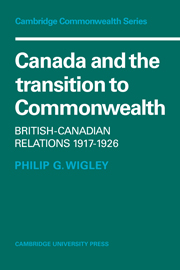Book contents
- Frontmatter
- Contents
- Abbreviations
- Preface
- Introduction
- 1 The threshold of responsibility, 1900–1916
- 2 New departures, 1917–1918
- 3 The settlement of peace, 1919
- 4 Unity and equality, 1919–1921
- 5 The centre cannot hold
- 6 Canadian diplomacy and Imperial diplomacy: 1923
- 7 From Lausanne to Locarno
- 8 The 1926 Imperial Conference: equality defined
- Conclusion
- Bibliography
- Index
3 - The settlement of peace, 1919
Published online by Cambridge University Press: 26 March 2010
- Frontmatter
- Contents
- Abbreviations
- Preface
- Introduction
- 1 The threshold of responsibility, 1900–1916
- 2 New departures, 1917–1918
- 3 The settlement of peace, 1919
- 4 Unity and equality, 1919–1921
- 5 The centre cannot hold
- 6 Canadian diplomacy and Imperial diplomacy: 1923
- 7 From Lausanne to Locarno
- 8 The 1926 Imperial Conference: equality defined
- Conclusion
- Bibliography
- Index
Summary
On 8 October 1918 President Wilson received from the German government a note which agreed to his Fourteen Points as a basis for peace negotiations with the allies. After some clarification he accepted the German proposal, and on 23 October formally presented this bilateral understanding to the European allied governments, who were then invited to draw up the terms of an armistice. Thus began the long and complicated process of putting together a German peace settlement, an endeavour which from the start was marked by Wilson's assumption of two discrepant roles: the head of the most powerful allied state, but also the disinterested mediator between the belligerent European powers. In the months to come, the shaping of the peace treaties was to be strongly influenced by the president's ambivalent frame of mind. Yet Wilson was not to be the only allied statesman with an ambiguous relationship to the peacemaking. To a comparable degree the British prime minister was also subject to conflicting priorities, a reflection in particular of the empire's unsettled constitutional affairs. Lloyd George was about to represent the interests of Great Britain, whose security and economic welfare were intimately connected with a stable Europe; but he had also to make allowances for the views of the British dominions, whose governments had been given every assurance that they would be fully consulted in the making of peace.
- Type
- Chapter
- Information
- Canada and the Transition to CommonwealthBritish-Canadian Relations 1917–1926, pp. 67 - 95Publisher: Cambridge University PressPrint publication year: 1977

